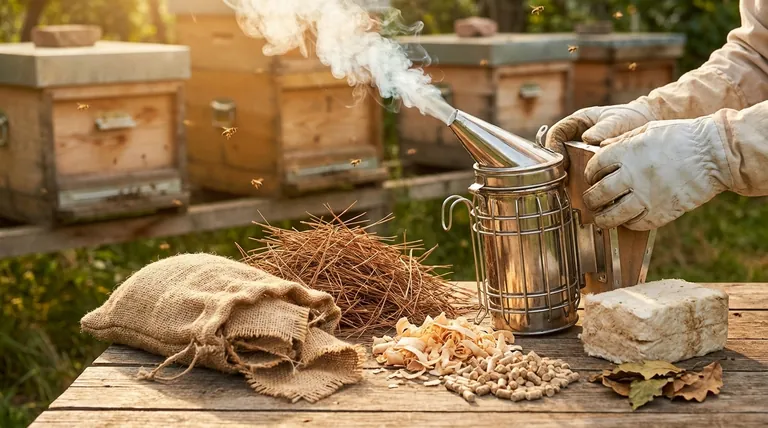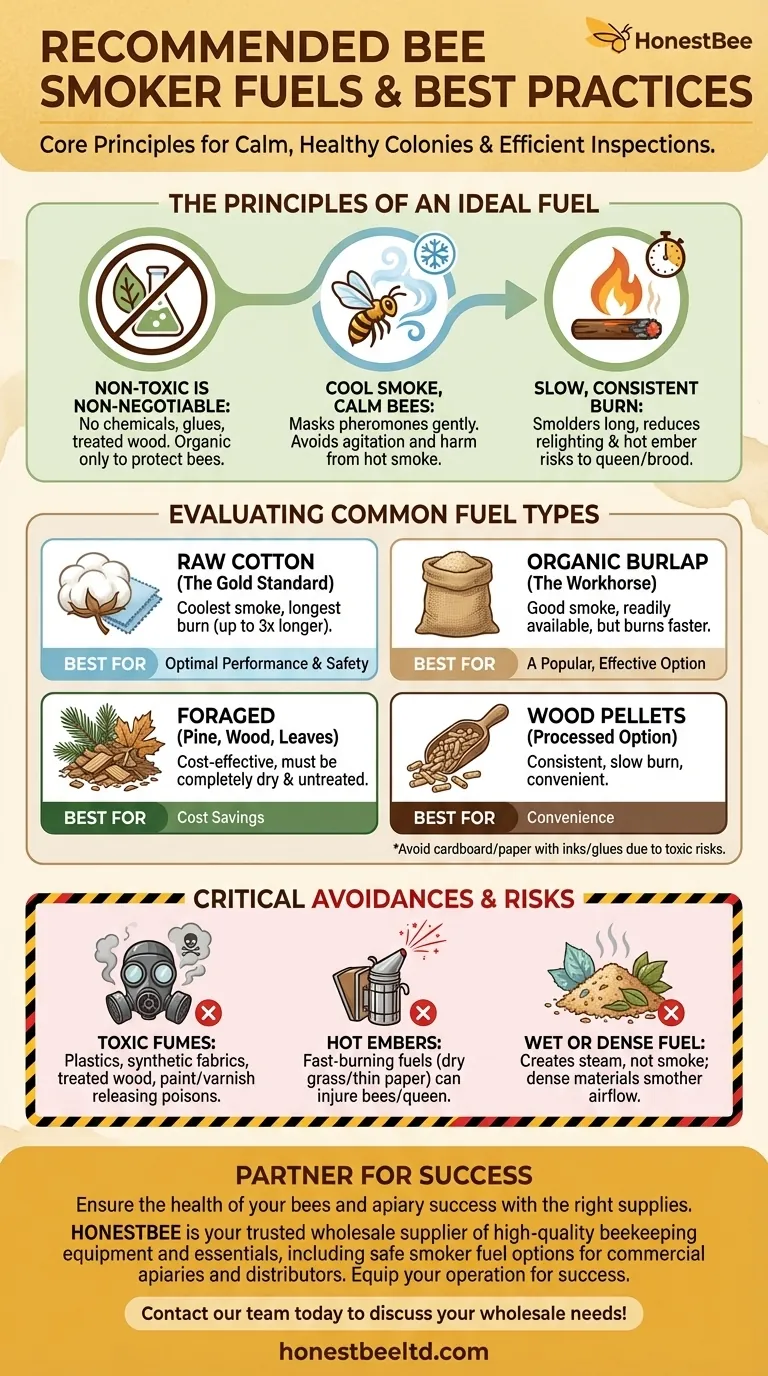In beekeeping, the most highly recommended smoker fuels are natural, non-toxic materials that produce a cool, consistent smoke. The best options include raw cotton, organic burlap, dry pine needles, untreated wood chips, and commercially produced wood pellets. The guiding principle is to select a fuel that smolders for a long time and is completely free of chemicals, glues, or toxins that could harm the bees.
Choosing the right bee smoker fuel is not about finding a single "best" material, but about understanding the core principles. The ideal fuel is always non-toxic, burns slowly, and produces cool smoke to calm your bees without harming them or the hive.

The Principles of an Ideal Smoker Fuel
To make an informed decision, it's crucial to understand what separates a good fuel from a dangerous one. The material itself is less important than its properties.
Non-Toxicity is Non-Negotiable
The health of your colony is paramount. The smoke is meant to calm bees, not poison them.
Therefore, you must avoid any materials that have been chemically treated. This includes treated lumber, cardboard with glossy inks or glues, and synthetic fabrics. Always opt for organic, natural sources.
Cool Smoke for Calm Bees
The purpose of smoke is to mask the alarm pheromones bees release, making them less defensive. It also encourages them to engorge on honey, which further reduces their tendency to sting.
Hot, acrid smoke can have the opposite effect, agitating the bees and potentially harming them. Fuels that produce a cool, gentle smoke are far more effective and safer for the colony.
Slow, Consistent Burn
A fuel that smolders for a long time is more practical and safer. A slow burn means you spend less time relighting your smoker during a hive inspection.
More importantly, it reduces the risk of shooting hot embers into the hive, which could injure or kill the queen and brood. Fuels that burn too quickly can create this hazard.
Evaluating Common Fuel Types
With these principles in mind, we can evaluate the most common fuel options available to beekeepers.
The Gold Standard: Cotton
Many experienced beekeepers consider raw cotton or scraps of all-cotton cloth to be the best fuel available.
It excels in producing a very cool smoke and can smolder for up to three times longer than other common fuels. This long, consistent burn makes it reliable and safe.
The Workhorse: Burlap
Burlap is a very popular and effective choice, often considered a close second to cotton. It is readily available and produces good quality smoke.
Its main drawback is that it burns much faster than cotton, requiring you to add more fuel during longer inspections. Be certain you are using organic, untreated burlap.
Foraged Fuels: Pine, Leaves, and Wood
Natural materials you can gather yourself are excellent, cost-effective options.
Dry pine needles, wood shavings (not dense sawdust), punk wood, and dry leaves are all fantastic choices. The key is ensuring they are completely dry and have not been exposed to pesticides or chemicals. Staghorn sumac bobs are also a classic, effective fuel.
Processed Options: Pellets and Paper
Commercially available pellet-stove fuel is a convenient, consistent option that burns slowly.
Tightly rolled paper or cardboard can be used, but you must be cautious. These materials may contain inks, glues, and other chemicals that can be toxic to bees when burned. If you are not certain it is clean, avoid it.
Understanding the Trade-offs and Risks
Choosing a fuel is also about understanding what to avoid. A poor choice can put your entire colony at risk.
The Danger of Toxic Fumes
Never use any material that could release toxic fumes. This is the most critical rule.
Avoid all plastics, synthetic fabrics, pressure-treated wood, and anything with paint or varnish. Be wary of using grass clippings, as lawns are often treated with chemicals.
The Problem with Hot Embers
Fuels that burn too fast and hot, like very dry grass or thin paper, can easily produce embers. These can be puffed out of the smoker and onto the bees or, worse, the queen.
A slow-smoldering fuel like cotton or wood pellets minimizes this risk significantly.
The Issue with Wet or Dense Fuel
Fuel must be dry to produce smoke. Wet or "green" material will only create steam, which does not calm bees and can make the hive environment damp.
Likewise, very dense fuel like sawdust can pack too tightly, preventing airflow and smothering the fire. Coarse wood shavings are a much better alternative.
Making the Right Choice for Your Goal
Your choice of fuel will depend on your priorities, budget, and what is readily available in your area.
- If your primary focus is performance and safety: Invest in raw cotton fuel for its exceptionally cool smoke and long, reliable burn time.
- If your primary focus is cost-effectiveness: Use properly dried, foraged materials like pine needles, untreated wood shavings, or punk wood from your local environment.
- If your primary focus is convenience: Purchase organic burlap or wood pellets, which provide a reliable and easy-to-use fuel source.
Ultimately, selecting a clean, slow-burning fuel is a critical step in ensuring the health of your colony and enabling a calm, productive hive inspection.
Summary Table:
| Fuel Type | Key Characteristics | Best For |
|---|---|---|
| Raw Cotton | Coolest smoke, longest burn time (up to 3x longer) | Optimal performance & safety |
| Organic Burlap | Good smoke, readily available, burns faster than cotton | A popular, effective workhorse |
| Pine Needles/Wood Chips | Cost-effective, must be completely dry and untreated | Beekeepers focused on cost savings |
| Wood Pellets | Consistent, slow burn, convenient | Beekeepers prioritizing convenience |
Ensure the health of your bees and the success of your apiary with the right supplies. HONESTBEE is a trusted wholesale supplier of high-quality beekeeping equipment and essentials, including safe, effective smoker fuel options, for commercial apiaries and beekeeping equipment distributors. Let us help you equip your operation for success. Contact our team today to discuss your wholesale needs!
Visual Guide

Related Products
- 54-Piece Smoker Fuel Pellets for Beekeeping Beehive Smoker Fuel
- Premium Traditional Copper Bee Smoker with Bellows
- Stainless Steel Honey Bee Smoker Hive and Honeycomb Smoker for Beekeeping
- Economy Galvanized Beekeeping Honey Bee Smoker for Wholesale
- European Stainless Steel Bee Smoker for Honey Bee Hive
People Also Ask
- What is the importance of fuel in a bee smoker? Ensure Cool, Calming Smoke for Your Hive
- What can I use for bee smoker fuel? Choose Safe, Natural Materials for a Calm Hive
- What is used in a bee smoker? Master the Best Fuels for Calm, Healthy Hives
- How should you start the fire in a bee smoker? A Step-by-Step Guide for a Calm Hive
- What to put in a bee hive smoker? A Guide to Natural, Calming Fuels



















